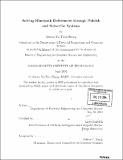| dc.contributor.advisor | Larry Rudolph. | en_US |
| dc.contributor.author | Huang, Jessica Yu-Tien, 1981- | en_US |
| dc.contributor.other | Massachusetts Institute of Technology. Dept. of Electrical Engineering and Computer Science. | en_US |
| dc.date.accessioned | 2005-09-26T20:15:17Z | |
| dc.date.available | 2005-09-26T20:15:17Z | |
| dc.date.copyright | 2004 | en_US |
| dc.date.issued | 2004 | en_US |
| dc.identifier.uri | http://hdl.handle.net/1721.1/28402 | |
| dc.description | Thesis (M. Eng.)--Massachusetts Institute of Technology, Dept. of Electrical Engineering and Computer Science, 2004. | en_US |
| dc.description | Includes bibliographical references (p. 85-87). | en_US |
| dc.description.abstract | Research in pervasive computing aims to fully integrate computing devices into our everyday environments in a seamless and efficient manner. Wireless technology such as Bluetooth takes us a step closer by replacing traditional cable connections with a more searnless communication transport, adding mobility and more human-centric computation. However, if we are to fully integrate this technology, we must first address some of its shortcomings, particularly those with respect to areas with a high density of Bluetooth devices. Four of these shortcomings: susceptibility to anonymous attacks, poor power management, synchrony requirement, and lack of friendships stem from the tight coupling of device interactions during the discovery protocol. One solution to this problem uses the advantages of publish and subscribe systems to decouple this interaction between smart mobile devices. Available devices can announce their availability to a central controller while devices interested in finding others can announce their interests. When a match occurs, the controller notifies both parties and provides information on how they can form a direct connection. This solution preserves the functionality of the Bluetooth connection protocol while circumventing the four shortcomings. The assumptions it makes are reasonable when placed in a the context of personal computing environment. Future considerations include optimizations that utilize caching, improvements on performance, increases in system capacity, and solutions for including dumb devices. | en_US |
| dc.description.statementofresponsibility | by Jessica Yu-Tien Huang. | en_US |
| dc.format.extent | 87 p. | en_US |
| dc.format.extent | 4361877 bytes | |
| dc.format.extent | 4371450 bytes | |
| dc.format.mimetype | application/pdf | |
| dc.format.mimetype | application/pdf | |
| dc.language.iso | en_US | |
| dc.publisher | Massachusetts Institute of Technology | en_US |
| dc.rights | M.I.T. theses are protected by copyright. They may be viewed from this source for any purpose, but reproduction or distribution in any format is prohibited without written permission. See provided URL for inquiries about permission. | en_US |
| dc.rights.uri | http://dspace.mit.edu/handle/1721.1/7582 | |
| dc.subject | Electrical Engineering and Computer Science. | en_US |
| dc.title | Solving Bluetooth deficiencies through publish and subscribe systems | en_US |
| dc.type | Thesis | en_US |
| dc.description.degree | M.Eng. | en_US |
| dc.contributor.department | Massachusetts Institute of Technology. Department of Electrical Engineering and Computer Science | |
| dc.identifier.oclc | 56985007 | en_US |
